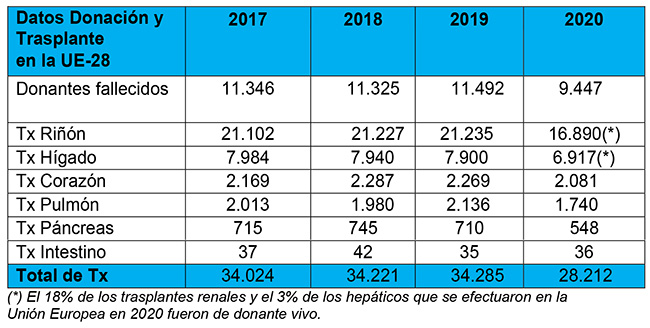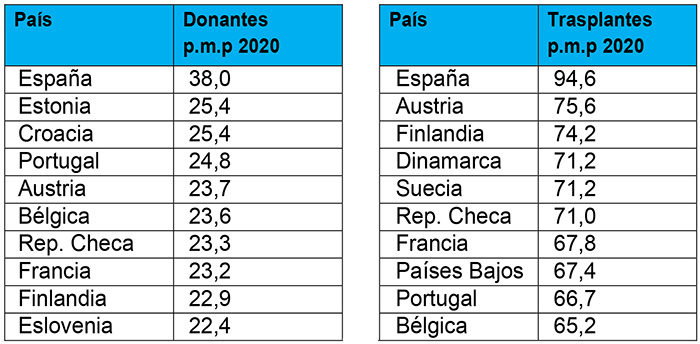Spain maintains its world leading position in organ donation in 2020, despite the pandemic
News - 2021.8.16
Their data are collected annually in the Council of Europe's "Transplant Newsletter", which will soon be published on the website of the National Transplant Organisation.
According to the Global Registry, 122,341 transplants were performed in 2020 in the 82 countries participating in this edition of the "Transplant Newsletter". Of these, 76,397 were kidney transplants (30% living donor), 30,275 liver transplants (18% living donor), 7,840 heart transplants, 5,765 lung transplants, 1,910 pancreas transplants and 151 intestine transplants. These transplants were made possible by 34,739 deceased donors, in addition to 28,635 living donors (23,153 kidney and 5,482 liver). Global transplant activity decreased by 18% compared to 2019. Heart transplantation was the most resilient to the pandemic, with an 8% decline. The number of deceased donors decreased by 13%, while the number of living donors decreased by 32%.
This decline in activity, common to most countries in the world, has been a consequence of the COVID-19 pandemic. The collapse of health systems and the saturation of intensive care units in successive waves of the epidemic justify the decline of an activity highly dependent on the availability of critical care resources. Uncertainty about the impact of infection on the transplant patient at the beginning of the pandemic also explains this decline due to an initial reluctance to transplant in a setting of sustained community transmission. The overall decline in activity occurred mainly during the first wave of COVID-19, with a subsequent recovery of programmes in most countries.
Despite the pandemic, donation in asystole or cardiac arrest has remained active in the 22 countries with this programme, according to data available in the Global Registry. Asystole donation is an important avenue for the expansion of deceased donation. Spain is the country with the highest rate of asystole donors in the world. In fact, this type of donation in Spain represents 37% of the donors in asystole in the European Union (EU) as a whole.
Despite the effects of the health crisis, Spain remains the world leader in donation, with a rate of 38 donors per million population (p.m.p.) for 29 consecutive years in 2020. The World Transplantation Registry works with the population of the United Nations Fund, which explains the discrete difference between this rate and that published earlier this year by the ONT with the population of the National Institute of Statistics.
The Global Registry also reflects Spain's important contribution to organ donation: last year, Spain accounted for 19% of organ donations in the EU and 5% of those registered in the world, despite the fact that Spain represents only 9% of the European population and 0.6% of the world's population. Moreover, despite the decline in Spanish activity due to the pandemic, the figures recorded by Spain in 2020 were far higher than those of any other country in the world during the years prior to the health crisis. These data show the resilience and recovery capacity of our transplantation system in a highly complex epidemiological environment.
In terms of transplant activity, Spain reached a rate of 94.6 transplants p.m.p. in 2020, a figure only surpassed by the United States, with 120.6 transplants p.m.p., partly due to its significant living donor transplant activity.
Spain leads the European Union
The effects of the pandemic have also been evident in the recorded donation and transplantation activity in the EU. With 9,447 donors and a rate of 18.4 deceased donors p.m.p., 28,212 organ transplants were performed in the EU last year, which corresponds to a rate of 55 transplants per p.m.p. As in the rest of the world, the decline in donation and transplantation has been 18% in the European Community, after years of progressive increase in activity.
The evolution of activity in the EU over the last few years:

The EU countries with the highest donation and transplantation rates are as follows:

In terms of the waiting list, at 31 December 2020, the number of patients waiting for organ transplantation in the EU stood at 57,717. According to the same data, 11 patients died every day in the EU while waiting for a transplant.
Activity in other countries
In the United States, the deceased donation rate has increased to 38 donors p.m.p., with a total of 12,588 deceased donors. It is one of the few countries where deceased donation has not declined during the pandemic. As in previous years, the dramatic epidemic of injecting drug use deaths in this country has contributed to this. However, live donation decreased by 23% and transplant activity by 2%, compared to 2019.
Australia and Canada, countries that in recent years had experienced an improvement in their activity levels after incorporating elements of the Spanish Transplant Model, have also suffered setbacks due to the pandemic. With rates of 18.3 donors p.m.p. in Australia and 19.5 donors p.m.p. in Canada in 2020, their decline has been 16% and 11%, respectively.
Latin America, with which Spain has been collaborating for 15 years through the Ibero-American Network/Council for Donation and Transplantation (RCIDT), both in terms of management advice and training of professionals in transplant coordination, has also been greatly affected by the health crisis, which forced several countries to halt or slow down transplant programmes. Although the COVID-19 pandemic has particularly impacted this region of the world, in 2020 they registered 6.8 donors p.m.p., resulting in 11,094 transplants. Among the countries that have best withstood the virus, Uruguay stands out, with 18 p.m.p. donors. This is followed by Brazil (14.2 p.m.p.) and Argentina (9.8 p.m.p.).
The World Transplant Registry, the most accurate source of information
In the last year, countries from other regions of the world such as Albania, Kenya and Pakistan have joined the "Transplant Newsletter". Already 82 states have provided their data for this new edition. This reflects the fact that, despite the difficulties, most countries have made efforts to maintain and protect their donation and transplantation programmes. Not only that, but they have reinforced their commitment to the World Transplant Registry and have provided their activity data to consolidate this entity as the main source of information on the subject.
International data ratify Spain's world leadership in this field. Last year, 1,777 deceased donors and 270 living donors were registered in Spain, which allowed 4,427 transplants to be carried out. A total of 2,702 kidney, 1,034 liver, 278 heart, 336 lung, 73 pancreas and 4 intestinal transplants were performed.
The 2021 edition of the "Transplant Newsletter", the official publication of the Council of Europe's Commission on Transplantation, will be available on the ONT website (www.ont.es) in the coming days. Activity data is also available on the Global Donation and Transplantation Observatory (http://www.transplant-observatory.org/).
Non official translation




